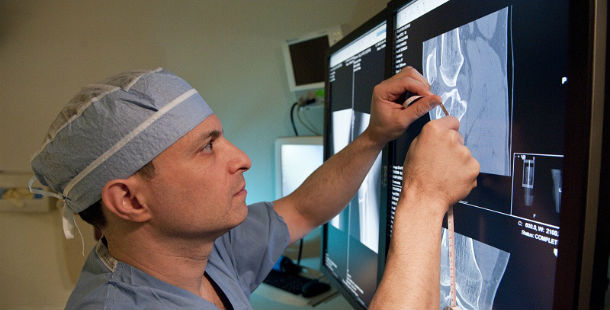Revision ACL Reconstruction

One of the most common knee injuries is a torn ligament, and the anterior cruciate ligament (ACL) is the one we often read about in the sports pages. Athletes who participate in cutting and pivoting sports such basketball, soccer, football, skiing and lacrosse are more prone to an ACL injury.
Many people, especially younger active patients or athletes seeking to return to a sport, opt for ACL surgery to repair the torn ligament. About 100,000 ACL reconstructions are performed in the United States each year, and overall, it is a highly successful operation. Innovative surgical techniques allow us to more precisely reproduce the anatomy and function of the original ACL. Although primary ACL reconstruction has a high success rate, some patients are left with unsatisfactory results or they reinjure the ligament. About 10% of the ACL reconstructions performed in the United States fail within 10 years.
What is a revision ACL reconstruction?
A revision ACL reconstruction is a second surgery needed to repair a torn anterior cruciate ligament. ACL revision surgery is a more challenging operation for the orthopedic surgeon than a primary reconstruction. Primary ACL reconstructions may be performed using different techniques, so the surgeon doing the revision must take multiple factors into account when planning for this more complex procedure.
Why did my reconstructed ACL fail?
The main reasons a patient might need a revision ACL reconstruction include:
- a reinjury of the ACL
- problems arising from the previous surgery
- failure of the reconstructed ligament to heal properly
How do I know if I need a second ACL surgery?
Generally, patients know when there is a problem. Bad signs after ACL surgery include recurrent instability or other symptoms, even after extensive rehabilitation. After a primary ACL reconstruction, patients must also avoid returning to a sport too soon.
How does revision ACL reconstruction work?
A number of options exist for revision ACL reconstruction, including using one of the patient’s own tendons. The patellar tendon, quadriceps tendon, hamstring tendon or allograft tissue may be used. The use of a tendon from the patient’s other knee is sometimes considered, as well. Additionally, a lateral extra-articular tenodesis may be performed at the time of ACL revision reconstruction in some cases to reduce the risk of reinjury. This procedure involves taking a strip of the iliotibial band and passing it deep to the proximal fibular collateral ligament to attach it to the distal femur. This procedure adds support to the ACL graft to reduce the risk of reinjury. Lastly, in rare cases, a slope correcting tibial osteotomy may be considered to decrease the risk of further reinjury.
Is a second ACL surgery really necessary?
The decision to proceed with a second ACL surgery depends on the patient, the condition and stability of his or her knee, the desired activity level and imaging findings. Patients are advised to seek out a specialist with ample experience in revision ACL surgery for the best chance of a good outcome.
Because revision ACL reconstruction is a more difficult operation to perform compared to primary ACL surgery, patients should choose an orthopedic surgeon with ample experience and with whom they feel comfortable. The doctor should take the time to answer all of a patient’s questions in nontechnical terms.
Many, but not all, patients opt for revision surgery. People who do not experience instability in their knee and do not wish to return to cutting and pivoting sports may decide not to have surgery. If they wish to remain active, they may engage in a different sport. However, patients who are left with an unstable knee or are enthusiastic about returning to their athletic activity of choice generally opt for revision surgery.
What questions should I ask my doctor before having a second ACL reconstruction?
When considering whether or not to have a second ACL surgery, patients might want to ask their doctor the following questions:
- Why was the first operation unsuccessful?
- What will happen if I don’t have revision surgery?
- Do I have any other knee injury (such as a torn meniscus or other cartilage damage) that may affect the outcome of revision surgery?
- What will my recovery and rehabilitation be like?
- What are the risks of a second surgery?
- How can I avoid reinjuring my knee?
Patients are also advised to inquire about the doctor’s experience in ACL revision surgery, as well as the hospital’s safety and infection rates.
How do I avoid a second ACL surgery?
The best way to prevent the need for revision ACL surgery in the first place is to do certain exercises to increase strength and balance. The other option is to stop playing cutting and pivoting sports, substituting other athletic activities in which the risk of ACL injury is low. Such activities include swimming, cycling, jogging and weight training.
What is the recovery for revision ACL reconstruction like?
In general, rehabilitation following ACL revision reconstruction is similar to physical therapy after primary ACL reconstruction. Sometimes rehab after revision surgery takes a bit longer. With careful planning, many patients can have excellent results and return to a very high level of activity without knee instability.
Updated: 10/16/2023
Authors
Attending Orthopedic Surgeon, Hospital for Special Surgery
Professor of Orthopedic Surgery and Professor of Public Health, Weill Cornell Medical College
